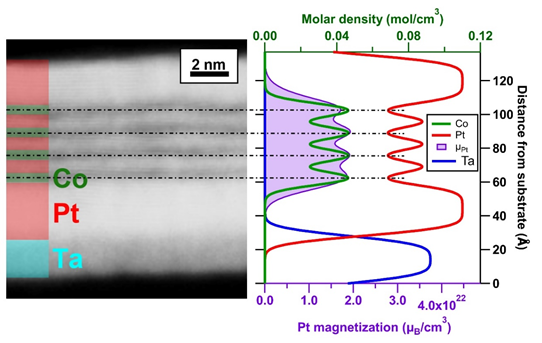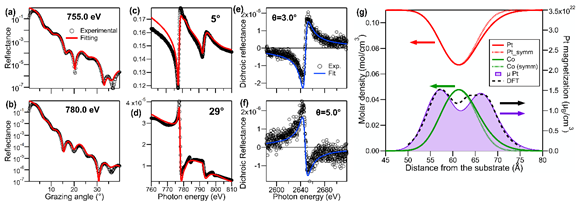Do you want to keep up to date? Subscribe to our newsletter. 1mail every 2months! |
 |

Left: Transmission electron microscopy (HAADF) image of a SiOx/Ta (30 Å)/Pt (22 Å)/[Pt(8 Å)/Co (6 Å)]4 /Pt (30 Å) multilayer. Right: The corresponding elemental depth profile and the distribution of Pt magnetic moment (violet area), obtained by the fitting of the RXR measurements.
Cerdanyola del Vallès, 1st April 2022 Spintronics exploits the use of the spin of conduction electrons as a further degree of freedom for the design of new electronic devices and is nowadays largely applied in the fabrication of hard disk read head and of magnetic RAMs.
Hence, spintronics is at the base of many proposed future developments in information and communication technology. In particular, the magnetic heterostructures based on ferromagnetic (FM) / heavy metal (HM) interfaces, such as the cobalt-platinum (Co/Pt) multilayers, are considered key materials for the construction of very effective electrodes in spin valves/magnetic tunneling junctions and synthetic antiferromagnets.
Their strong out-of-plane magnetization allows the perpendicular recording, resulting in higher information storage density and speed. Moreover, Co/Pt interfaces are able to stabilize peculiar chiral spin configurations (skyrmions) that pave the way for the design of innovative devices.
All these suitable properties are strongly related to the so-called magnetic proximity effect (MPE), whose origin is recognized to be the hybridization between the HM-5d and the FM-3d bands at the FM/HM interface, resulting in an induced magnetic moment on the heavy metals in the first atomic layers close to the interface.
Recent studies, designed to quantify the HM induced moment in FM/HM architectures, observed an asymmetric MPE in HM/FM/HM trilayers, with a HM induced moment that is typically higher at the top interface. Discovering the origin of this asymmetry and its control are obviously of fundamental importance for practical applications.
An international collaboration, including Università Roma Tre, Consiglio Nazionale delle Ricerche, Università Politecnica delle Marche (Italy), University of Augsburg (Germany), AGH University of Science and Technology (Poland), and the ALBA Synchrotron, has combined advanced spectroscopic techniques, microscopy and density functional theory calculations in a comprehensive study aimed to clarify the origin of this asymmetry both in Pt/Co/Pt trilayers and, for the first time, in multilayered systems.
The results of the study have been published in a recent article on ACS Applied Materials & Interfaces. In particular, resonant X-ray reflectivity measurements, using the scattering endstation MaReS at the BOREAS beamline of ALBA, allowed to determine with sub-nanometric resolution the distribution in depth of the elements in the grown heterostructures, as well as the magnetization depth profile of the Pt atoms induced by the adjacent Co atoms through MPE.
The study demonstrated experimentally that the occurrence of the asymmetric MPE in the Pt/Co/Pt trilayer is preserved even in [Co/Pt]4 multilayers, with a larger extent of the Pt magnetic moment in the (Co/Pt)top interface. The fine characterization techniques, applied to disclose the compositional and magnetic features of the heterostructures, allowed to correlate the asymmetric distribution of Pt magnetic moments with the interdiffusion processes occurring during the growth and, in particular, to the different interface roughness as a function of the deposition order of the transition metals (Co on Pt or vice versa).
The outcome of this study will help to clarify the factors determining the asymmetric MPE and can serve as a recipe for the detailed characterization of the structural and magnetic properties of transition-metal heterostructures, aimed to optimize the growth conditions. This will provide useful guidelines to the design and production of advanced spintronic devices based on multilayered systems.

(a-d): Examples of RXR measurements (empty circles) at values of photon energy close to the Co L2,3 edge and the corresponding best fitting curves (solid red lines). θ-2θ angular scans at fixed photon energy values of 755 eV (a) and 780 eV (b). Photon energy spectra at 5° (c) and 29° (d) constant grazing angle θ. (e-f): Examples of dichroic RXR spectra across the Pt M3 edge at θ=3° (e) and θ=5° (f) (empty circles) and the corresponding best fitting curves (blue solid lines). (g): Concentration depth profile of Pt (solid red line) and Co (solid green line) and magnetization depth profile of Pt (violet shaded area) obtained from the fitting of the experimental reflectivity measurements. The Pt magnetization profile obtained from the experiment is compared with profile calculated through DFT (dashed black line). Symmetric concentration profiles of Pt (dotted red line) and Co (dotted green line) are reported to highlight the difference between the two interfaces.
Reference: A. Verna, P. Alippi, F. Offi, G. Barucca, G. Varvaro, E. Agostinelli, M. Albrecht, B. Rutkowski, A. Ruocco, D. Paoloni, M. Valvidares and S. Laureti. Disclosing the nature of asymmetric interface magnetism in Co/Pt multilayers. ACS Applied Materials & Interfaces (2022).
With the collaboration of Fundación Española para la Ciencia y la Tecnología. The ALBA Synchrotron is part of the of the Unidades de Cultura Científica y de la Innovación (UCC+i) of the FECYT and has received support through the FCT-20-15798 project.





